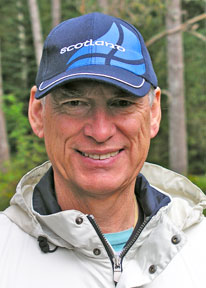My November 2012
newsletter discussed the vital role of asteroids in Earth’s
development. Asteroids brought water from the Solar System’s “snow line”
to our initially dry rock. Much later, a devastating asteroid impact
aided the ascension of mammals by killing off the dinosaurs and about
75% of all then-living species. That asteroid is estimated to have been
12 kilometers (7 miles) across.
But now
that humans are Earth’s dominant species, asteroids are no longer a good
thing. More devastating impacts would be “overkill.”
In February
2012, an 18-meter (60-feet) wide asteroid exploded near Chelyabinsk,
Russia, with more than 20 times the energy of the Hiroshima bomb. The
asteroid arrived without any warning, in part because it came from the
direction of the Sun, where conventional telescopes are useless.
In 1908, a
40-meter (130-feet) wide asteroid exploded over the remote Siberian
region of Tunguska, releasing the energy of a 10-megaton bomb and
killing everything in 1000 square miles, about the size of the San
Francisco Bay Area.
The question is not: “Is
an asteroid coming that could kill millions of people, or even all of
us?” Such an asteroid is certainly coming; the only question is: “When?” It is unlikely to come in the near future, but it will come one day.
Here’s the
good news: of the many recurring natural disasters – earthquakes,
tsunamis, hurricanes, tornados, etc. — asteroid impacts are the only
catastrophes that we could prevent. But we must choose to act.
Saving
Earth doesn’t require new science — we already know enough — but it does
require technology development and political will and consensus.
Shielding Earth involves three basic steps: (1) detecting asteroids that
pose serious threats; (2) establishing plans to deflect dangerous
asteroids into new orbits that avoid Earth; and (3) implementing those
plans.
Here’s a
technical overview. Earth and billions of asteroids orbit the Sun. An
asteroid will hit us if it and Earth arrive at the same time, at an
“intersection”, a place where their orbits cross. We can avoid a
collision by deflecting the asteroid, by pushing it so it either: (1)
orbits faster and goes through the intersection before Earth does; or
(2) orbits slower and arrives after Earth has passed. Earth’s orbital
velocity is 19 miles per second, which means the intersection point will
sweep all the way across Earth’s surface in about 7 minutes. If an
asteroid is going to hit us, we need to speed up or slow down its
arrival by several minutes.
Deflecting
an asteroid can be done by: (1) slamming a rocket into it; (2)
gravitationally pulling on it with a rocket hovering nearby; or (3) a
combination of both — brute force and precision.
If we reach
that asteroid 7 years before impact, we only need to change its
velocity by 1 part per million. If we get there 20 days before impact,
the velocity change must be 1 part per thousand. Therefore, it pays to
detect dangerous asteroids far in advance — we should avoid “crash”
programs.
Now let’s discuss the greatest challenge: politics.
Below is a
map showing one possible example. The “risk corridor” is the red line,
with X marking the asteroid’s impact point if we do nothing. Speeding up
the asteroid moves X along the risk corridor toward the right, while
slowing it down moves X left.

If we
deflect the asteroid sufficiently, its impact point moves off either the
left or right end of the risk corridor and all Earthlings are saved.
But, here’s the rub: what if the deflection is only partially
successful? What if we move the impact only part way along the risk
corridor?
In the
above example, with no deflection the asteroid would impact the
northeast Pacific Ocean, possibly causing devastating tsunamis in Hawaii
and the West Coast. We might choose to slow the asteroid and move X
left toward Siberia. But, the Russians would likely prefer moving X to
the right toward the Panama Canal and Central America. Who gets to
choose?
Imagine the
nightmare scenario: four irreconcilable nations launch rockets that
push a major asteroid in different directions, cancelling each other’s
deflections, and ensuring the demise of all mankind.
It would be
sensible for all nations to agree on an equitable decision-making
procedure well in advance of a specific threat. (What am I smoking?)
Where do we stand, back in the real world?
Governments
are doing very little about asteroids. None is developing rocket
technology for asteroid deflection. Annual NASA spending on asteroid
detection was $20M in 2012. That’s what the U.S. government spends every
3 minutes. Since the U.S. has found 98% of all detected asteroids, the
rest of the world must be doing even less. NASA claims to have detected
90% of near-Earth asteroids over 1 kilometer (0.6 miles) across, which
could devastate an entire nation, and only 1% of the smaller
city-killers.
Former
astronauts Ed Lu and Rusty Schweikart and others formed the private
non-profit B612 Foundation to do what the Feds won’t. (In March 2013, I
interviewed Schweikart on my radio show; listen to it for free here.).
B612 is soliciting $400M in private donations to design, build, and
launch Sentinel, an advanced infrared telescope that will orbit the Sun
at about the same distance as Venus. Looking outward, every relevant
asteroid will be in Sentinel’s field of view. During its 6½ year
mission, Sentinel is expected to detect 500,000 near-Earth asteroids,
including over 90% of those over 140 meters (500 feet) across with
impact energies over 100 megatons.
The B612
Foundation says we should stop being passive passengers on spacecraft
Earth, and become its crew. They sell a coffee mug that says:
“Don’t be a Dinosaur!”
Best Regards,
Robert
January 21st, 2014

Author of 3 print books

and 26 Everyone's Guide Series e-Books
Web: GuidetotheCosmos
Note: Previous newsletters can be found on my website.
|